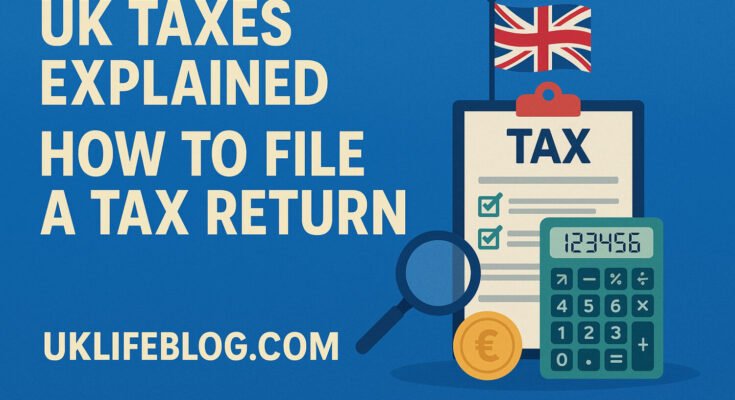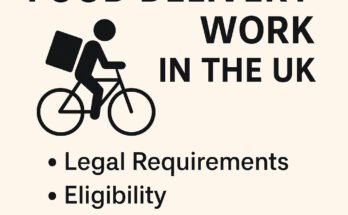Understanding how to file a UK tax return can be confusing, especially for first-time filers or those with multiple income sources. Whether you’re self-employed, a landlord, or have other untaxed income, this comprehensive guide will help you navigate the process with clarity and confidence. We’ll cover everything from determining if you need to file a return, registering for self-assessment, completing the tax return, submitting it online, and avoiding common mistakes and penalties.
1. Introduction to UK Tax System
The UK operates a self-assessment tax system, meaning it is the taxpayer’s responsibility to declare their income and calculate the tax owed. While most employees pay tax through PAYE (Pay As You Earn), many people are required to submit a self-assessment tax return each year.
If you’re wondering how to file a tax return in the UK, you’re not alone. This guide will break it down step by step.
2. Who Needs to File a Tax Return?
You must file a tax return if in the last tax year (6 April to 5 April):
- You were self-employed and earned more than £1,000
- You were a partner in a business partnership
- You earned more than £100,000
- You had income from renting out property
- You earned foreign income
- You received dividends or savings income that isn’t taxed at source
- You had capital gains tax to pay
- You claimed child benefit and your income was over £50,000
Check if you need to file on the official HMRC page: Here
3. Registering for Self-Assessment
Before you can file a tax return, you must register for self-assessment. Here’s how:
- Visit: Here
- If you’re self-employed, use form SA1
- If you’re not self-employed, register with the appropriate form depending on your situation
- You will receive a Unique Taxpayer Reference (UTR) within 10 days
- Set up your Government Gateway account to access the online filing portal
It’s essential to register early to avoid late filing penalties.
4. Key Deadlines to Remember
- Register for Self-Assessment: 5 October following the end of the tax year
- Paper Tax Return Deadline: 31 October
- Online Tax Return Deadline: 31 January
- Tax Payment Deadline: 31 January (first payment) and 31 July (second payment on account, if applicable)
Late filings or missed payments can lead to penalties, so mark these dates on your calendar.
5. Documents You’ll Need
Gather the following before you file:
- UTR number
- National Insurance number
- P60 or P45 (if employed)
- P11D (for benefits and expenses)
- Invoices or receipts (if self-employed)
- Bank interest statements
- Dividend vouchers
- Pension statements
- Rental income records
- Foreign income details
Having these documents on hand makes it easier to learn how to file a tax return accurately.
6. Step-by-Step Guide: How to File a Tax Return
Step 1: Log In
Visit here and log in using your Government Gateway ID.
Step 2: Choose the Right Sections
The online system customizes sections based on your circumstances. Select the sources of income that apply to you (e.g., self-employment, property, capital gains).
Step 3: Enter Your Income
Enter all forms of income. Be precise and ensure figures match your documents.
Step 4: Claim Allowable Expenses
For self-employed individuals, this includes:
- Office costs
- Travel expenses
- Staff costs
- Financial charges
Step 5: Add Tax Reliefs
You can claim reliefs for:
- Pension contributions
- Gift Aid donations
- Professional subscriptions
Step 6: Review Your Tax Calculation
The system will calculate the tax due. Double-check all entries.
Step 7: Submit Your Return
Once satisfied, submit the return online and print or save the confirmation.
7. Common Mistakes to Avoid
- Missing the registration deadline
- Submitting late
- Entering incorrect figures
- Forgetting to claim allowable expenses
- Ignoring payment deadlines
- Failing to keep proper records
Learning how to file a tax return properly means avoiding these common errors.
8. What Happens After You File
After submission:
- HMRC will confirm receipt
- You’ll receive your tax bill (if not already visible online)
- You can appeal if there are errors
- HMRC may request more information
9. How to Pay Your Tax Bill
Payment methods include:
- Online or telephone banking
- Debit or corporate credit card online
- At your bank or building society
- By BACS or CHAPS
Use your UTR as the payment reference. Full guide here
10. Penalties and Appeals
Late filings are subject to:
- £100 penalty (even if no tax is due)
- Further penalties after 3, 6, and 12 months
Late payments accrue interest and surcharges. You can appeal penalties through your HMRC account or by post.
11. Helpful Resources and Tools
- Check if you need to file
- Register for self-assessment
- Self-assessment tax return login
- Calculate your tax
- Help and contact HMRC
12. Frequently Asked Questions (FAQs)
Do I need to file if I am employed and earn under £100,000?
Not usually, unless you have other income.
Can I file a paper tax return?
Yes, but only until 31 October.
What if I made a mistake?
You can amend your return within 12 months.
Do I pay tax when I file?
No, payment is separate and due by 31 January.
What if I can’t pay on time?
Contact HMRC immediately to arrange a payment plan.
13. Conclusion
Filing a UK tax return doesn’t need to be intimidating. By understanding how to file a tax return and staying on top of deadlines, you can avoid penalties and reduce stress. Use this guide as your go-to reference each year. Bookmark the key HMRC resources and keep your financial records organized. Whether you’re new to self-assessment or need a refresher, this comprehensive guide covers everything you need to know about how to file a tax return in the UK.
Read more here




